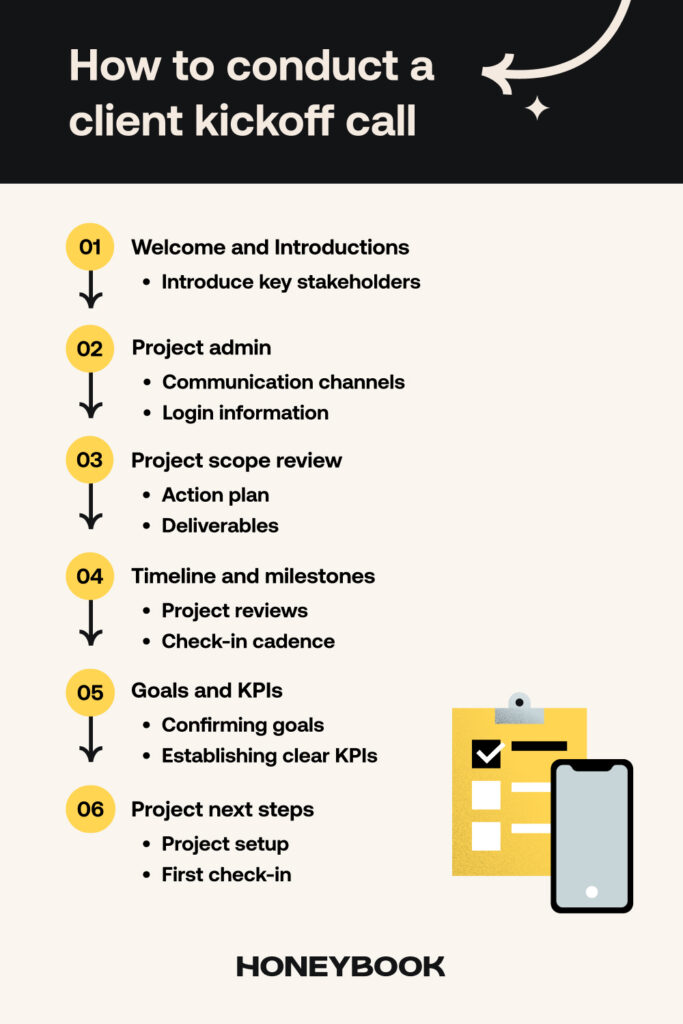Before you move forward with project execution, it’s important to make sure you’re on the same page with new clients. By conducting a client kickoff call, you can align on project scope, action items, project timeline, and more. Here’s what to keep in mind.
You’ve moved through your sales process, potentially gone back and forth, and finally booked the client. Right after paying the invoice and/or signing the contract, it’s time to set expectations, align on project goals, and set the tone for how you and your client will work together.
The best way to do this is with a kickoff call. Rather than an email or document, you want to come together with a clear understanding of the project details and make the time for questions that might come up in real time. That way, you can easily move through the rest of your client onboarding process.
Here’s everything you need to conduct a successful project kickoff.
Jump to:
- What is a kickoff call?
- What to do before a kickoff meeting
- What to include in your kickoff agenda
- What takeaways should come out of a successful kickoff meeting?
- What can go wrong without a kickoff call?
- Better client relationships from start to finish with HoneyBook

Skip the back-and-forth: Schedule meetings, sessions, consultations, and more in one click.
What is a kickoff call?
Within your onboarding workflow, a kickoff call starts a project after you and your client have made an agreement on the services you’ll deliver. For an independent business owner, it can be an opportunity for the project manager to introduce the client to the entire project team, ask and answer questions, and align on your project overview.
During the call, you and the client should review the project requirements, goals, and fill in any missing information. It’s a great way to discuss the project plan at a high level, while also honing in on some specifics like the project timeline, roles and responsibilities, and deliverables.

What to do before a kickoff meeting
We don’t recommend going into your kickoff call without any prep work. You want to make sure you cover all agenda items and get the most out of the meeting, so that means finalizing the booking process, putting together an actionable agenda, and connecting with your internal team.
Make sure you have all of the necessary documents from your clients
Keep in mind that a kickoff call is similar but different from a discovery call. At this step, you should already understand your client’s needs and which services you’ll be providing. You know they’re a good fit for your business, so there’s no need to re-hash the details you already covered when they were a lead.
A number of things should be set in place prior to your kickoff call, namely:
- Deliverables are agreed upon
- Contracts should be signed
- A deposit or retainer should be paid
- An agreed-upon deadline for final deliverables should be set
These items are a part of the first two phases of your clientflow. You’ll already have qualified the client, determined what they’re looking for, and signed a contract. That’s nearly half the process of booking a client!
With all of these logistical elements out of the way, you’re ready to set a date for a kickoff call.
Determine the goals of your kickoff call
The number one goal of a kickoff call regardless of the size of your business or company is to become aligned on key details. The idea behind the call is to determine the details that will lead you to fulfill the goal of your client’s project. You’ll
- Determine the purpose of the project
- Identify an overarching goal for the project
- Create a step-by-step action plan with key deliverables
- Determine how the deliverable goals will be met within the project timeline
- Confirm any communication preferences (daily updates, weekly updates, etc.)
A less technical goal of the kickoff call is also the most under-discussed goal of the meeting: building rapport.
Prepare for the meeting
Nothing beats great preparation for an informational meeting. Be sure you prepare for the meeting and present as organized as possible. Coming into a kickoff meeting with all of your ducks (read: paperwork and deadlines) in a row will give the client room to breathe.
The more logistical details you take off of their plate, the more space they have to provide details that may not have come up otherwise. In order to prepare for a client kickoff call, prepare the following:
- Any notes from prior conversations
- Emails about the project
- Answers from a client onboarding questionnaire you might have already sent when your client booked
- Invite your clients to the project in your HoneyBook account, if applicable
- Outline instructions for using any collaborative software (i.e., HoneyBook, or invite your client to a Slack channel and explain how it’s used)
- Any remaining background questions you have for your client
- A tentative project roadmap with key timestamped checkpoints
- A formal presentation (if you’re pitching a logo or graphics or a website design)
Review the names of everyone you’ll be working with so that there are no embarrassing “remind me of your name again?” moments.
Conduct an internal kickoff meeting
During your internal meeting, ensure that each stakeholder and project team member is aware of the meeting goals and action items. You may want to designate someone to take meeting notes or break up the agenda between each stakeholder.
You can also review the prep work you’ve done with the entire team to ensure nothing is missing.
What to include in your kickoff agenda
Provide a project kickoff meeting agenda in the meeting invitation so the client has a chance to bring any and all sharable resources. The more information you have about your client and their project, the more likely your deliverable will align with your client’s needs.
Here’s a short example of a kickoff meeting agenda:
- Welcome and introductions
- Project admin (when and where to communicate, any login information that needs to be shared, etc.)
- Project scope review
- Timeline and milestones
- Goals and KPIs
- Next steps
What list of questions should you ask your new client?
A number of logistical and technical elements should be covered in a kickoff call so your client has ultimate clarity on how to communicate with you. Some of these are the following:
- Can you go over the goals and objectives of what you’re looking for in detail?
- Who are other key stakeholders I (or we) should be aware of working on this project?
- What are your key performance indicators for the success of your project?
- Are there any standards or project requirements we should be aware of?
- Are there any risks we should be aware of?
- What is your preferred communication method?
- What is your ideal schedule for check-ins? Would you like an update daily, weekly, or monthly (change this to suit the type of project you’re working on)?
You’ll be aiming to address all or most of these questions in a reasonable time frame. How long should a kickoff meeting really take, you ask?
How long should a kickoff call be?
The length of a kickoff call is a choose-your-own-adventure situation. Typically, attention spans wane after about 30 minutes (or even before) so it’s optimal to keep meetings as short as possible. If you have an hour’s worth of material to cover, of course, or your client is asking a lot of questions, it’s best to air on the side of too much rather than too little in the calendar invite.
How to build rapport in a kickoff call
Building rapport in a kickoff call is much like building relationships outside of a business transaction. Be sure to express your enthusiasm for meeting the client and helping them with their need. Find a common ground or overlapping interest you can reference to keep the client invested in the conversation.
Take the time to listen and ask open-ended questions that stimulate conversation. The more you can get the client to speak about their goals for the project off the cuff, the better idea you’ll have of that client’s end goals for your services.
What takeaways should come out of a successful kickoff meeting?
Follow up your kickoff call with a recap email summarizing what you covered and a brief thank you note. Ask the client if they have any further questions that arose after you left the call. Show your new client how personable you are—it will go a long way.
Internally, you should record your meeting minutes and notes in your project management software and update your project plan there if needed. Then, start assigning next steps and tasks to stakeholders.
What can go wrong without a kickoff call?
The point of a kickoff call is to open the dialogue with your client and learn about any last-minute crucial details of their project. Without a kickoff call, independent business owners risk a few things.
Misaligning the timeline
When you meet with a client, you learn a lot about their personality and expectations for the deliverable. The more details you have about a project, the more able you’ll be to adequately plan for the different stages of the deliverables. A kickoff call gives you space to collect the details you need to accurately pace your work.
Misunderstanding project expectations
A client kickoff call is a perfect time for both paries to ask any clarifying questions. Without this alignment, you can risk scope creep with your client. The last thing you need is your client asking for more work or getting frustrated because the project details weren’t clear. Luckily, all of this will be addressed on the kickoff call.
Kickoff FAQs
Why should you have a project kickoff?
A project kickoff ensures everyone is aligned on the project scope, goals, and timelines. It sets expectations and establishes clear communication channels, laying a strong foundation for project success.
How long should a kickoff meeting be?
The length of a kickoff meeting varies but should generally be kept short to maintain attention. Typically, aim for around 30 minutes to an hour, adjusting based on the complexity of the project and the number of questions from the client.
Who is responsible for keeping the kickoff meeting on track?
The project manager or the person leading the project is responsible for keeping the kickoff meeting on track. They should guide the conversation, ensure all agenda items are covered, and manage the time effectively.
What happens after the kickoff meeting?
After the kickoff meeting, the project team should start executing the project plan. The project manager will assign tasks, set up communication channels, and monitor progress to ensure the project stays on track.
Better client relationships from start to finish with HoneyBook
Kicking off a project is a lot of work, but there’s much more to client relationships and project management. From booking to scheduling your kickoff meetings and gathering information, HoneyBook provides a platform to do it all.
Store valuable information about your clients and offer a professional client portal where they can also keep track of communications and project statuses. You’ll never risk an unhappy relationship when everyone is constantly on the same page.

Easily keep track of all your clients and projects using HoneyBook.



